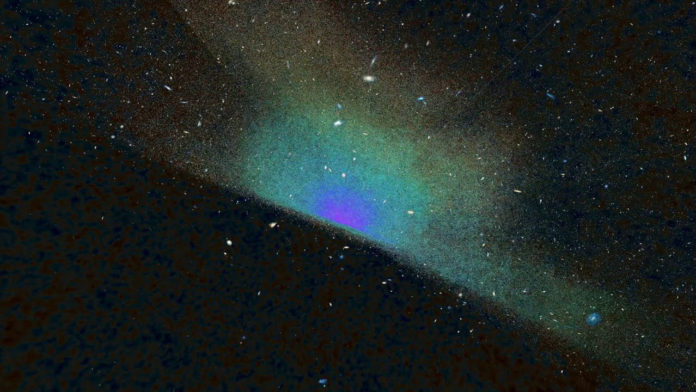After analyzing several million galaxies and quasars, an international consortium of scientists has retracted a more continuous history of the Universe. They have created the largest 3D map of the Universe produced to date.
It is the fruit of a twenty-year collaboration of several hundred scientists from around thirty different institutions around the world, all united within the “Sloan Digital Sky Survey” (SDSS), with data collected from an optical telescope dedicated to the project located in New Mexico, in the United States.
Resulting from the analysis of several millions of galaxies and quasars, this latest survey builds upon existing data as early as 1998 to fill specific gaps in cosmological history and to improve our understanding of the mechanisms underlying the expansion of the Universe.
This latest cosmological survey of the SDSS, called “The extended Baryon Oscillation Spectroscopic Survey” (eBOSS), includes more than 100 astrophysicists, of which several are researchers from EPFL. Jean-Paul Kneib, who heads EPFL’s Astrophysics Laboratory (LASTRO), initiated the eBOSS survey and was its principal investigator (PI) for several years.
Jean-Paul Kneib, who heads EPFL’s Astrophysics Laboratory (LASTRO) said, “In 2012, I launched the eBOSS project with the idea of producing the complete 3D map of the Universe throughout the lifetime of the Universe, implementing for the first time celestial objects that indicate the distribution of matter in the distant Universe, galaxies that actively form stars and quasars. It is a great pleasure to see the culmination of this work today.”
On account of the extensive theoretical models portraying the Universe after the Big Bang, as well as observation of the Cosmic Microwave Background Radiation (CMBR), the infant universe is moderately well known. Scientists have also investigated its expansion history over the most recent few billion years from Supernovae distance measurements and galaxy maps, including those from past phases of the SDSS.
Cosmologist Kyle Dawson of the University of Utah said, “We know both the ancient history of the Universe and its recent expansion history fairly well, but there’s a troublesome gap in the middle 11 billion years. Thanks to five years of continuous observations, we have worked to fill in that gap, and we are using that information to provide some of the most substantial advances in cosmology in the last decade.”
Will Percival of the University of Waterloo, eBOSS’s Survey Scientist, said, “Taken together, detailed analyses of the eBOSS map and the earlier SDSS experiments, we have now provided the most accurate expansion history measurements over the widest-ever range of cosmic time. These studies allow us to connect all these measurements into a complete story of the expansion of the Universe.”
The final map shows filaments of matter and voids that more precisely define the structure of the Universe since its beginnings when it was only 380,000 years old. From there, scientists measured the recurring patterns in the distribution of galaxies, thus identifying several key cosmological parameters, including the density of hypothetical dark matter and energy in the Universe, with a high degree of precision.
For this survey, scientists take a gander at different galactic tracers that reveal the mass distribution in the Universe. For the part of the map relating to the Universe six billion years ago, scientists observed the oldest and reddest galaxies.
For more distant eras, they concentrated on the youngest galaxies, the blue ones. To go back further, that is to say, up to eleven billion years, they used quasars, galaxies, whose supermassive black hole is extremely luminous.
This map reveals the history of the Universe, and in particular that the expansion of the Universe began to accelerate at some point and has since continued to do so. This seems to be due to the presence of dark energy, an invisible element that fits naturally into Einstein’s general theory of relativity but whose origin is not yet understood.
The currently accepted expansion rate, called the “Hubble constant,” is 10% lower than the value calculated from the distances between the galaxies closest to us. It is unlikely that this 10% difference is random due to the high precision and wide variety of data in the eBOSS database.
